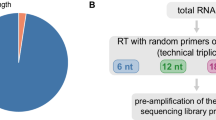Abstract
Transcriptomic research using microarrays and RNA-Sequencing (RNA-seq) is now possible starting from minute biological samples, such as clinical specimens or embryos, due to the development of highly sensitive and reproducible cDNA synthesis methods. Here, we describe a quick method of RNA amplification and double-stranded cDNA synthesis starting with 10 ng of high-quality total RNA extracted from porcine embryos. The final product (double-stranded DNA) is adequate for the detection by RNA-seq of protein-coding transcripts, as well as of all the other classes of noncoding RNAs, including pseudogenes.
Access this chapter
Tax calculation will be finalised at checkout
Purchases are for personal use only
Similar content being viewed by others
References
Malone JH, Oliver B (2011) Microarrays, deep sequencing and the true measure of the transcriptome. BMC Biol 9:34
Cho RJ, Campbell MJ (2000) Transcription, genomes, function. Trends Gene 16(9):409–415
Costa V, Angelini C, De Feis I et al (2010) Uncovering the complexity of transcriptomes with RNA-Seq. J Biomed Biotechnol 2010:1–19
Zheng D, Frankish A, Baertsch R et al (2007) Pseudogenes in the ENCODE regions: consensus annotation, analysis of transcription, and evolution. Genome Res 17(6):839–851
Nygaard V, Hovig E (2006) Options available for profiling small samples: a review of sample amplification technology when combined with microarray profiling. Nucleic Acids Res 34(3):996–1014
Van Gelder RN, von Zastrow ME, Yool A et al (1990) Amplified RNA synthesized from limited quantities of heterogeneous cDNA. Proc Natl Acad Sci 87(5):1663–1667
Kamme F, Salunga R, Yu J et al (2003) Single-cell microarray analysis in hippocampus CA1: demonstration and validation of cellular heterogeneity. J Neurosci 23(9):3607–3615
Morris J, Singh JM, Eberwine JH (2011) Transcriptome analysis of single cells. J Vis Exp :2634
Kurimoto K, Yabuta Y, Ohinata Y et al (2006) An improved single-cell cDNA amplification method for efficient high-density oligonucleotide microarray analysis. Nucleic Acids Res 34(5):e42
Tang F, Barbacioru C, Wang Y et al (2009) mRNA-Seq whole-transcriptome analysis of a single cell. Nat Methods 6(5):377–382
Kurn N, Chen P, Heath JD et al (2005) Novel isothermal, linear nucleic acid amplification systems for highly multiplexed applications. Clin Chem 51(10):1973–1981
Acknowledgements
This research was supported by the Natural Science and Engineering Research Council of Canada, EmbryoGENE Strategic Research Network.
Author information
Authors and Affiliations
Corresponding author
Editor information
Editors and Affiliations
Rights and permissions
Copyright information
© 2014 Springer Science+Business Media New York
About this protocol
Cite this protocol
Tsoi, S.C.M., Dyck, M.K. (2014). RNA Amplification for Pseudogene Detection Using RNA-Seq. In: Poliseno, L. (eds) Pseudogenes. Methods in Molecular Biology, vol 1167. Humana Press, New York, NY. https://doi.org/10.1007/978-1-4939-0835-6_9
Download citation
DOI: https://doi.org/10.1007/978-1-4939-0835-6_9
Published:
Publisher Name: Humana Press, New York, NY
Print ISBN: 978-1-4939-0834-9
Online ISBN: 978-1-4939-0835-6
eBook Packages: Springer Protocols




